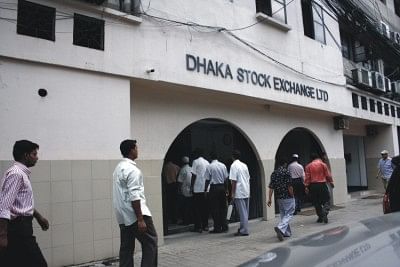The perils of buying on margin

Investors should be cautious. Photo: Amdadul Huq/ Drik News.
THE Daily Star's February 9 report that the SEC cut the ratio of brokerage houses' margin loans to equity ratio from 1:1.5 to 1:1 (henceforth called, margin requirement ration: MRR) has drawn my attention and concern. If I am not mistaken, a 1:1.5 MRR allows margin loan 150 percent of the market value of marginable stocks and 1:1 MRR means 100 percent. In the US, the MRR is 50 percent or 1:0.5.
The SEC's MRR is perilously high, exposing margin investors to a potential financial disaster in particular and the entire market participants in general, to serious threats of potential losses in the event of a crash. Similar MRRs were maintained prior to the 1929 near ruinous US stock market crash. Even at 50 percent MRR, I lost 80 percent of my portfolio's value when margin calls kept coming almost daily as the market was plummeting progressively during 2000.
Buying stocks on margin is similar to buying houses on mortgage loans -- the former uses the portfolio of stocks as collateral and the latter uses the house -- and both loans charge interest. As long as you make timely payments, house price falling below the mortgage loan doesn't affect you immediately unless you apply for refinancing the mortgage or put the house for sale. With margin loans, a fall in the market value of the portfolio below the loan amount will trigger "margin calls" asking the investor to immediately restore the MRR, otherwise the brokers will liquidate a part of the portfolio to maintain the ratio and the action will continue as the market keeps tumbling.
Regardless of how the stocks are performing, one still has to pay interest on that loan. If the stocks pay high dividends, this money can defray some or all of the interest costs of the margin loan. At a time of continually sinking stock prices, losses can escalate drastically to a point of utter helplessness and nervous breakdown. In the 2000 US stock market debacle there were incidences of suicides and shooting of stock brokers by clients.
In an overheated market dynamics, if the market were to take a stumble, margin calls could gyrate into a crash. The US Congress believed this was what happened in 1929, when margin debt equalled 30 percent of the stock market's value. That is why it gave the Federal Reserve power to control initial margin requirements in the Securities Act of 1934. Since then MRR has been changed 23 times. It has been as high as 100 percent, meaning that none of the purchase price could be borrowed. Since 1974, MRR has been unchanged, at 50 percent, allowing investors to borrow no more than half the purchase price of equities directly from their brokers.
The purposes of the 1934 Act regulating the MRR were to: (1) reduce excessive credit, and divert more credit toward productive uses, (2) safeguard investors from debt driven speculative bubbles, and (3) reduce price fluctuations caused by margin buying and short selling.
The Fed left the MRR unchanged for the last 36 years, even when looming market bubbles turned into crashes, in order to avoid making the crashes more debilitating. Judging from that perspective, Bangladesh SEC's revising the MRR four times in short span of two months -- fearing market overheating and bubble forming -- seems erratic, if not opaque and desultory.
A stock market, by nature, reacts almost instantaneously to news and noise -- good or bad -- driven by policy and non-policy shocks. Margin loan has usually been regarded as one of the sources of instability in financial markets. This source of price volatility is characterised as a "pyramiding-depyramiding'' process -- one that implicitly assumes speculation as the source of instability. This speculation is generally formed due mostly to excessive infusion of funds into the stock market in a low margin regime.
In a 2001 paper, using post 1934 US stock market data, Gikas Hardouvelis (University of Piraeus) and Panayiotis Theodossiou (Cyprus University of Technology) have shown that higher initial margin requirements are associated with lower subsequent stock market volatility during normal and bull periods, but found no relationship during bear market. Higher margins are also negatively related to stock returns, apparently because they reduce systemic risk.
They concluded that a sensible rule for setting margins (or other regulatory restrictions) is to lower them in sharply declining markets in order to boost liquidity and avoid a de-pyramiding effect in stock prices, but subsequently raise them and keep them at the higher level in order to prevent a future pyramiding effect.
My 1993 paper "Macro-econometrics of Stock Price Fluctuations" (Quarterly Journal of Business and Economics) has shown that stock prices respond to changes in long-term interest rates, money growth, budget deficits, output growth, inflation, and gasoline prices. In my study, MRR had no effect on stock prices since it did not change (after 1974) during the sample period of my analysis. While margin loans may not provide support for regulating future MRR to restrain volatility, it doesn't rule out the possibility of margin buying contributing to speculative boom.
Considerable research recently also shows that margin requirements have no impact on volatility. The latest research by Fed economist Paul Kupiec concludes "there is no substantial body of scientific evidence that supports the hypothesis that margin requirements can be systematically altered to manage the volatility in stock markets."
Nonetheless, advocates of higher margin requirements, such as Yale University economist Robert Shiller, argue that higher MRR can be an important signal indicating that the Fed is serious about cooling an overheated market (which essentially amounts to announcement effects).
Three prudent recommendations: (a) Following the US Fed, power to set initial MRR be given to Bangladesh Bank while allowing brokerage firms to have some leeway up to 10 percent, (b) bring down the MRR to 50 percent in slow steps, (c) keep constant vigilance against increases in margin debt -- both in aggregate value and relative to market capitalization -- reaching near an unsustainable level, threatening marked crash.
Dr. Abdullah A. Dewan, founder of politiconomy.com, is a Professor of Economics at Eastern Michigan University.

 For all latest news, follow The Daily Star's Google News channel.
For all latest news, follow The Daily Star's Google News channel. 



Comments